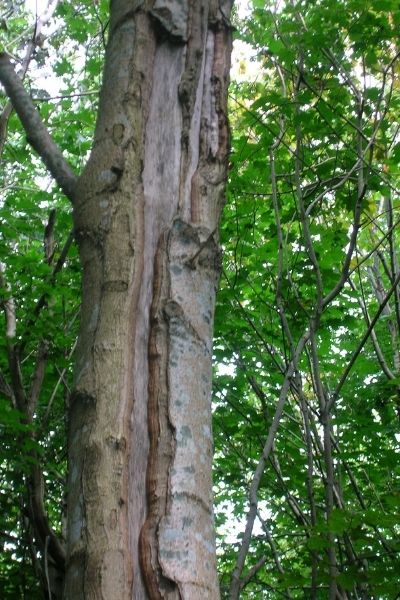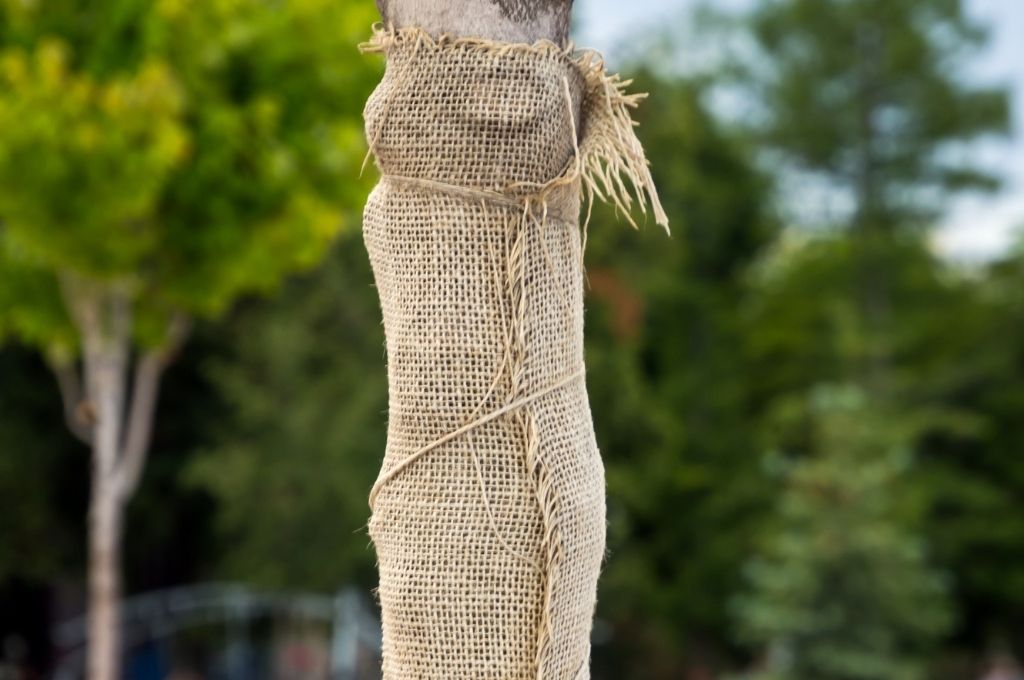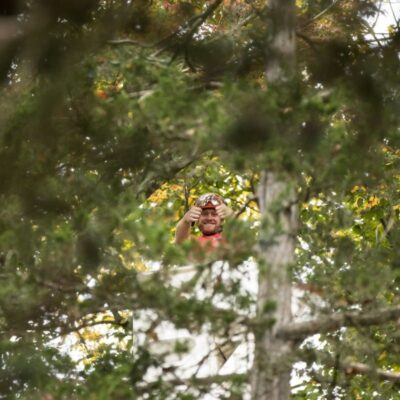Winter can be hard on everyone, and that includes your trees. Winter temperatures that fluctuate during the day and overnight can stress dormant trees in several ways, with one of the most common being frost cracks. Ever thought you’ve heard a sharp rifle shot out of nowhere from a snowy forest, woodland, or your own garden? It could be a frost crack announcing itself.
While we can bundle up in extra layers when temperatures drop or remove those layers as it warms up, trees don’t have any outerwear beyond their bark to protect themselves from fluctuating winter temperatures. And when those temperatures rise or fall suddenly, frost cracking often results.
In This Article …
In this article, we answer some of the most-asked questions about frost cracks in trees, including:
- What a frost crack is and what it looks like
- What causes tree bark to split in winter
- When trees are more likely to get frost cracks
- Why it makes such a loud noise when a tree cracks
- If frost cracking can kill or damage a tree and what you should (and should not) do about it
- How to prevent your trees from cracking in freezing weather, and where to avoid planting new trees
- Which trees are most likely to get frost cracks
- And more!
What are frost cracks?
Frost cracks are vertical cracks in a tree’s bark and wood that appear on its trunk or branches in winter.
While humans aren’t built the same way as trees, we both have internal systems full of water that are covered by a protective layer. In winter, we’re protected by extra layers and heated buildings, but trees endure sudden and extended periods of temperature changes outdoors. Sometimes these temperature changes are greater than a tree’s structure can endure. The result of winter weather changes can cause frost cracking.
What causes frost cracks in trees?
Frost cracking is caused by the tree’s inability to endure the expansion and contraction of its bark and wood that results from the expansion of water inside its wood.
Ever put a bottle or can in the freezer and forgotten about it? You might find it cracked open, in a pool of frozen wine or soda. Water responds to temperature changes by expanding. While cooling water initially contracts, freezing water expands by as much as 10%. Note that warming water also expands!
Because water expands when it freezes, it takes up more space. Rigid “containers,” such as a tree’s bark and the wood just beneath the bark, can’t always flex enough to accommodate the expanding water. The result? Cracks in the tree as the water molecules inside the tree’s cells expand.
When do frost cracks happen?
Frost cracks are most likely to occur when there are larger fluctuations between daytime and night-time temperatures.
In winter, sunny days with warm temperatures heat up the tree’s bark and its internal layers near the bark’s surface, causing them to expand. The warmer the temperatures get and the longer the warming lasts, the deeper the warming will extend into the tree’s tissues and the more the bark and wood will expand.
When those warm daytime temperatures plunge in the afternoon and freeze overnight, the surface bark cools quickly and contracts. However, wood that is deeper inside the tree cools and contracts more slowly. As a result, the more rapidly contracting surface bark is stretched taut over the still-expanded inner wood. After a certain point, the shrinking bark (and, often, the wood layers immediately beneath it) can no longer hold together, and it cracks.
Where do frost cracks usually appear?
You’ll most often find bark cracks on the south and west sides of a tree. This is because these sides receive the most hours of warming sunlight before night-time temperatures drop.
Why do frost cracks make such a loud noise?
The rifle shot sound that frost cracks make is the sudden snapping of wood that has reached its limit of flexibility. It’s sudden because until that moment the tree has maintained its tensile strength. As soon as the forces of expansion and contraction exceed the wood’s strength, the wood fails all at once.
Freezing temperatures usually reduce outside activity and noise, snowfall muffles sound, and cold, still air carries sound well. Together, these factors help amplify the sudden sound of wood cracking.

Frost cracks on trees can grow wider if they are damaged every year.
Do frost cracks close up on their own?
The wounds from frost cracks may never fully seal up and may reopen during subsequent winter temperature fluctuations. However, healthier trees are better able to seal off (compartmentalize) the vulnerable or diseased area to safeguard the rest of the tree’s internal system.
Trees also respond to frost crack damage by creating “reaction wood.” This new growth around the damaged area can help seal it up. Reaction wood is stimulated to grow after dormancy ends when all parts of the tree have woken up and are growing again. If reaction wood is successful, the wound will be buried within new growth layers and be less likely to crack again during freezing winter weather.
Can you repair a frost crack?
Trees have built-in methods to control and isolate areas of disease or decay. The best way to deal with frost cracking is to let your tree do its work.
Don’t use a sealant or patch to cover the crack. Just like sealing the surface of pruning cuts, this is an old habit that has been proven detrimental to tree health.
Can frost cracks kill a tree?
Maybe, although it’s not the frost crack itself that kills a tree. A tree’s bark is its protection. When that protective bark is breached by frost cracking, the tree’s internal wood is left vulnerable to attack. The open wound allows insect pests and diseases to get a foothold inside the tree, potentially killing it.
Can you prevent trees from cracking in winter?
You can’t control the weather, and you can’t bring your trees inside for some cocoa, but you can help them endure the worst winter weather and resist frost cracks.
Follow these tips to help prevent trees from cracking in winter:
- Ensure your trees are as healthy and vigorous as possible
- Irrigate your trees during dry winter periods (well-hydrated trees are less susceptible to all sorts of damage, including freezing)
- Add compost to your soil in spring and/or fall
- Spread a 2-4” layer of organic mulch around the tree’s dripline in the fall to help minimize temperature fluctuations in the soil during winter’s freeze/thaw cycles
- Provide organic and slow-release fertilizers for the growing season
- Wrap trunks with burlap in winter, when it’s feasible to do so
- Don’t prune your tree if you don’t know how to do it correctly—hire a professional!
PRO TIP: Wrapping tree trunks with burlap provides some protection from temperature extremes and also helps prevent winter sunscald on young trees. Just remember to remove the wrap as soon as temperatures rise and the risk of freezing weather has passed. If you leave it on too long, it’ll trap moisture against the tree’s bark, and you don’t want to provide a place for overwintering insect larvae to hatch.
And don’t suddenly change the environment around an existing tree by clearing away all plants, shrubs, and adjacent trees (for example, during construction or major landscaping project). Doing so will expose the tree’s trunk and branches to unbuffered winter weather. You can shock your tree with the stress of this change and make it more susceptible to insects and disease, in addition to frost cracking and sunscald.

Wrapping burlap around young trees can protect the thin bark from frost cracks.
Which trees are more likely to get frost cracks?
Many common tree species are susceptible to developing frost cracks in winter, especially those with thin bark. You’re more likely to find vertical splits from frost cracks on:
- Beech
- Linden
- Maple
- Oak
- Sycamore
- Walnut
- Willow
We’re not suggesting that you shouldn’t plant these trees; they’re excellent choices for many Massachusetts landscapes. But do remember to check them (and all your trees) regularly for frost crack damage in winter. Keep your trees vigorous and irrigated, and you’ll lessen the severity of frost crack damage.
PRO TIP: Young trees with thin bark are often most susceptible to bark cracks in winter. They are also more susceptible to winter sunscald, which shouldn’t be confused with frost cracking. Sunscald can also damage or kill inner bark, but this damage won’t show up until after dormancy has ended and the young tree resumes growing. The dead or damaged areas will not grow and will appear sunken or discolored as the surrounding areas of healthy bark continue to grow.
Does location affect whether or not a tree will split in winter?
While you can’t move established trees to a more winter-friendly location (at least not easily!), you can choose where to plant a new tree. If you’re planting a new tree, especially one that’s more susceptible to frost cracking, locate it in an area with good growing conditions and where it will be protected from extreme temperature swings.
Follow good planting practices and avoid planting your new trees in areas that:
- Are fully exposed to strong winter winds
- Have shallow or infertile soil
- Have overly fast-draining soil
Think Your Trees Have Frost Crack Damage?
If you think your trees have sustained damage from frost cracks, give us a call. Often, your tree will be just fine. But trees that are stressed or in decline may not heal, leading to insect or disease problems and/or internal decay that could make it necessary to eventually remove the tree. We can evaluate any trees that show signs of frost cracks and give you advice about how to keep them healthy and resilient to prevent future problems.
Blog Topics
Recent Posts
What's Happening? Stay Informed!
Stay on top of local events, pest and disease updates, tree and landscape tips, and more. Delivered straight to your inbox each month.








